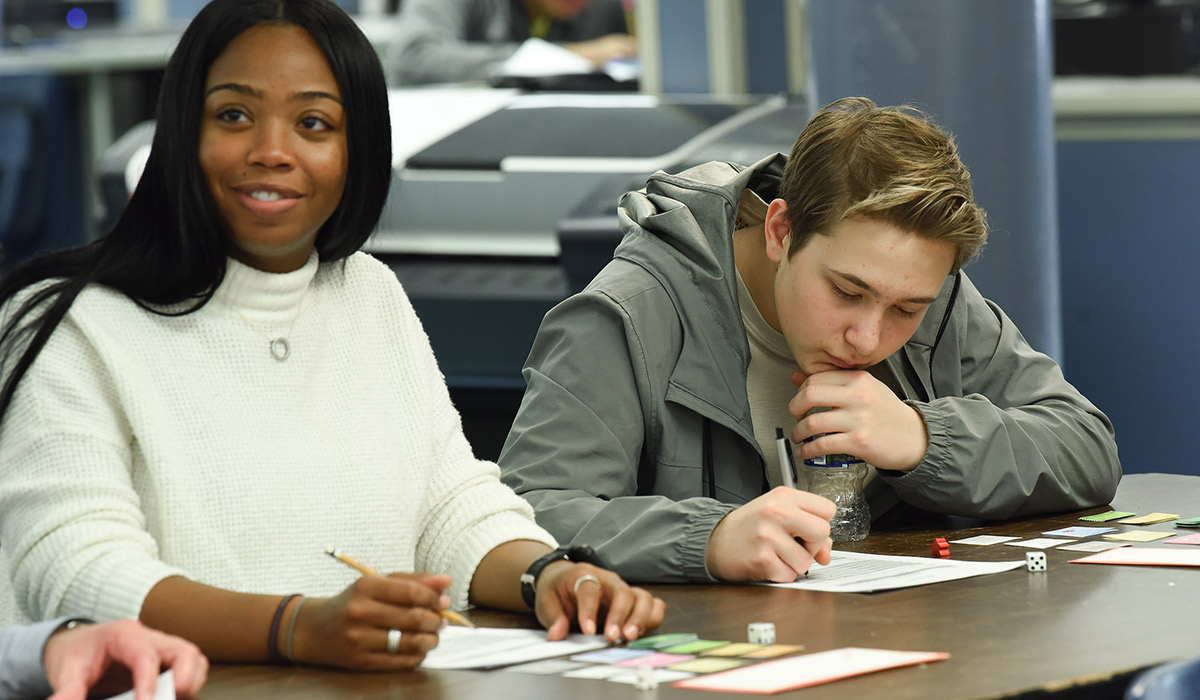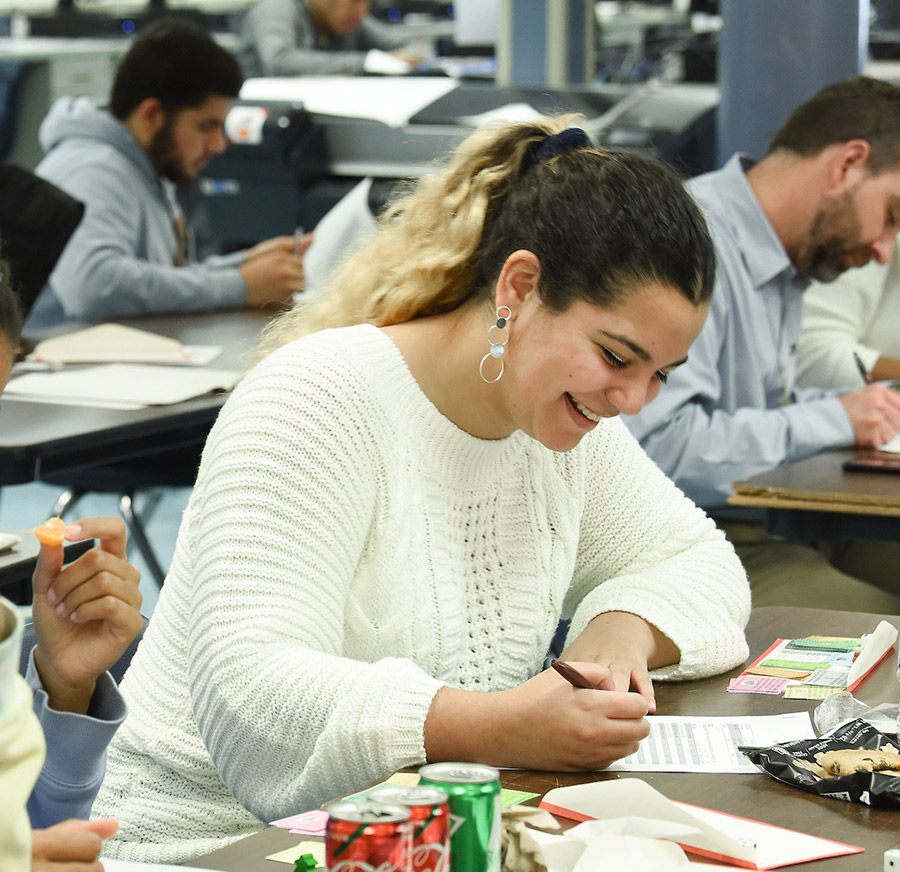

On a fall day, Catholic University Civil Engineering Professor Gunnar Lucko stood before a lab of students at Hayfield High School in Alexandria, Va., rolling dice to determine random numbers that would influence hypothetical project management decisions.
“It’s a five, everyone knows what that means,” Lucko announced to the class, as the group of students groaned, play money in hand. “Resource prices are high this week.”
The students were playing “Build It,” a game invented by Lucko with funding by the National Science Foundation. The game simulates the challenges faced by construction project managers working to complete tasks while staying on schedule and within budget. Over the course of a simulated 12 “week” game, students must complete eight tasks, while considering fluctuating market prices and events like equipment failure, employee strikes, or work that must be redone.
 On this particular afternoon, the students in the class became invested in the game, groaning or cheering as they were each dealt challenges and successes based on the roll of the dice. This enthusiasm was exactly what Lucko hoped for when he designed the game. He believes project management can teach students a lot about planning, organization, resource management, and communication.
On this particular afternoon, the students in the class became invested in the game, groaning or cheering as they were each dealt challenges and successes based on the roll of the dice. This enthusiasm was exactly what Lucko hoped for when he designed the game. He believes project management can teach students a lot about planning, organization, resource management, and communication.
Lucko was inspired by the board games from his native country of Germany, while also keeping the design simple enough that other engineering professors could easily print it and play with their students.
“I tried to keep the game elements as simple as possible but realistic with the game mechanics allowing you to profit and finish the project ahead of schedule, or go bankrupt,” he said.
Lucko’s development of “Build It” is just a small part of his work at Hayfield High School, where he has been a volunteer mentor since 2012 for ACE (Architecture, Construction, and Engineering), an after-school program for high school students.
Lucko is one of many faculty in the School of Engineering who is working to educate the next generation of engineers. He is joined by Greg Behrmann, clinical associate professor of biomedical engineering, who directs the Engineering New Frontiers summer camp for high school students and teaches Saturday classes as part of the College Board’s Upward Bound program, which helps D.C. high school students stay on track for attending college.
Behrmann is also a certified instructor for Project Lead the Way (PLTW), a curriculum that prepares high school students to be engineers. For the past two years, he has been an active volunteer with the PLTW program at Archbishop Carroll High School in D.C., where he has mentored teachers, taught in classes, and supported engineering activities — like the school’s annual “pumpkin chunkin’” event.
This fall, Behrmann invited four students from the program at Carroll (which is located just up Harewood Road from campus) to enroll in his ENGR 106 course, Computer Aided Engineering Tools. In addition to earning college credit, the students also gained confidence in a college-level classroom.
from campus) to enroll in his ENGR 106 course, Computer Aided Engineering Tools. In addition to earning college credit, the students also gained confidence in a college-level classroom.
“Their age difference as seniors is not that different from the other students [in the class], so I think it helped them see that college is manageable,” Behrmann said. “Only 15 percent of our college students have had this kind of exposure to computer aided design while in high school so this will give them an advantage.”
Michelle Ming is the program director for Carroll’s PLTW program. She said it has been beneficial to have Behrmann and Catholic University students helping at Carroll to show how engineering can be within reach for high school students. Last year, she noted, Behrmann was honored with one of the school’s Volunteer of the Year awards for all he has done to help with Project Lead the Way.
“It’s really important for students to be able to see that there is definitely a benefit to persevering and working hard, and that just because something is hard doesn’t mean it’s not worth doing,” Ming said.
“I think students are intimidated by the word engineering and how hard they think it will be. This gives them the opportunity to get familiar with concepts and ideas prior to walking into the college room. It takes the sting out from the fear of ‘Can I make it in college’ and ‘Am I good enough?’ and helps them understand what it takes to be successful in that environment.”
This spring, Ming and Behrmann will work together on the high school’s second annual STEM Expo, which gives students an opportunity to show what they have learned. Behrmann will also help seniors as they complete their final design project, a device to help a Capuchin College friar who is dealing with mobility challenges.
“We’re going to interview him to see what kind of project we can design that will make his quality of life better,” said Ming.
All of those projects align well with the interests of associate professor Otto Wilson, who also teaches biomedical engineering. Much of Wilson’s research involves finding new methods of teaching scientific concepts, often by integrating creative methods like storytelling or art.
“It is so important to help our youth in D.C. to ignite the spark of inspiration within their hearts and minds because they have so much talent that can contribute to addressing the various challenges on so many fronts that face our society,” Wilson said.
In November, Wilson collaborated with the Students Global Ambassador Program (SGAP Leaders) to help lead a Sustainability Challenge, involving more than 100 freshman and sophomores from the Washington Leadership Academy, a charter high school located within walking distance of Catholic University.
As part of the challenge, students were split into teams of 5-6 students who took on the roles of engineers, architects, and sustainability consultants to solve a case challenge of retrofitting the new AUDI Field soccer stadium in D.C. with solar panels. Catholic University undergraduate architecture and engineering students helped lead the teams and encouraged students to imagine walking in the steps of professional engineers and architects wrestling with a real-world challenge.
SGAP Leaders plan to hold another sustainability challenge at the University this spring, directed mainly toward female high school students.
“Getting young 7th-12th graders excited about STEM and engineering is critical to building the next generation of engineers and architects for 2030,” Wilson said. “All it really takes is spending a little time to encourage and mentor them to make wise choices and turn their talents towards addressing our needs in terms of the 14 engineering grand challenges that encompass aspects of biomedical engineering — discovery, space travel, pollution control, energy, ethics, and high quality education for all.”